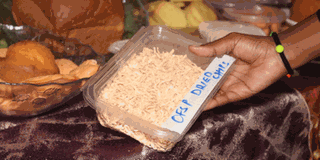Bake products from orange fleshed sweet potatoes

Dried pieces of orange sweet potato. From orange fleshed sweet potatoes, you derive puree which can be used as an ingredient for bakeries to make chapatis, mandazi, cakes, cookies and other baked goods. Photos by Christine Kasemiire
What you need to know:
Project. The root tubers and banana programme has injected $800,000(Shs2.9b) to cover Malawi, Kenya and Uganda. It aims at promoting growth, consumption and nutritional value of root and tuber crops. The two-year project will also entail training farmers to enable them capitalise on the orange fleshed sweet potato.
Imagine eating chapatis, cakes or taking juice made from sweet potato. Food scientists have encouraged the use of orange fleshed sweet potatoes to make different products.
Dark orange sweet potatoes are not only highly nutritious but also rich in Vitamin A.
“It is a normal sweet potato that is orange inside and is rich in beta-carotene that gives people vitamin A which is a big problem in East Africa in general,” Mr Tawanda Muzhingi, a food scientist at International Potato Centre said.
For the past 15 or more years, farmers have been encouraged to plant orange fleshed sweet potatoes.
However, adoption of the crop is low, scientists say.
“Orange fleshed sweet potatoes have been viewed as a poor man’s crop that had no value to it. So, we are transforming a sweet potato from a marginal crop to a high-value commodity by working on processing and value addition,” he says with the aim of unlocking the economic potential and consumption of the crop.
The technology will, according to scientists, not only add to Uganda’s health but also employ farmers growing the crop to earn some income.
Benefits
From orange fleshed sweet potatoes, you derive puree which can be used as an ingredient for bakeries to make chapatis, mandazi, cakes, cookies and other baked goods.
Orange fleshed sweet potato puree is a boiled or steamed sweet potato mashed into thick paste.
According to Mr Muzhingi, the puree is pivotal in cutting costs of making baked products.
“We have developed formulations in which you can replace half of the wheat requirements in making bread. So if your recipe for bread requires 100Kg of wheat, you can use half wheat and half puree,” he says.
Mindful that the cost of sweet potatoes is lower than wheat, the perks of the puree are incessant.
Using puree would also cut Uganda’s wheat import bill.

A fresh sweet potato. Farmers have been encouraged to plant orange fleshed sweet potatoes.
Potential
Mr Antonio Magnaghi, an application and process specialist Euro Ingredients Limited, has a 10-year experience in running a production development innovation centre in Nairobi.
At this job, he has provided technical support around sweet potato processing in different countries such as Rwanda and those in Europe.
He works with manufacturers to modify the equipment to enable them process sweet potatoes.
The innovation also presents an investment opportunity for processors to deal in manufacturing of puree which can be sold to bakeries as an ingredient for their final products.
Kenya is top consumer
Mr Muzhingi says Kenya is one of the leading consumer of the sweet potato puree professed through the uptake from big supermarket chains in the country. Malawi, Mozambique and Burkina Faso also have stakes.
“Currently Kenya consumes around 5 tonnes a week of puree, Malawi and Mozambique could each average around 2 tonnes a week,” he says.
Kenya’s consumption is envisaged to increase to about 10 tonnes a week in a period of three months.
Magnaghi advised the education system to boost innovation tailored especially at manufacturing ingredients to curb importation.
While he could not attach figures, Magnaghi said Uganda has over the years increased efforts in growing sweet potatoes.
The country now has more capacity since the soil and weather conditions are conducive.




